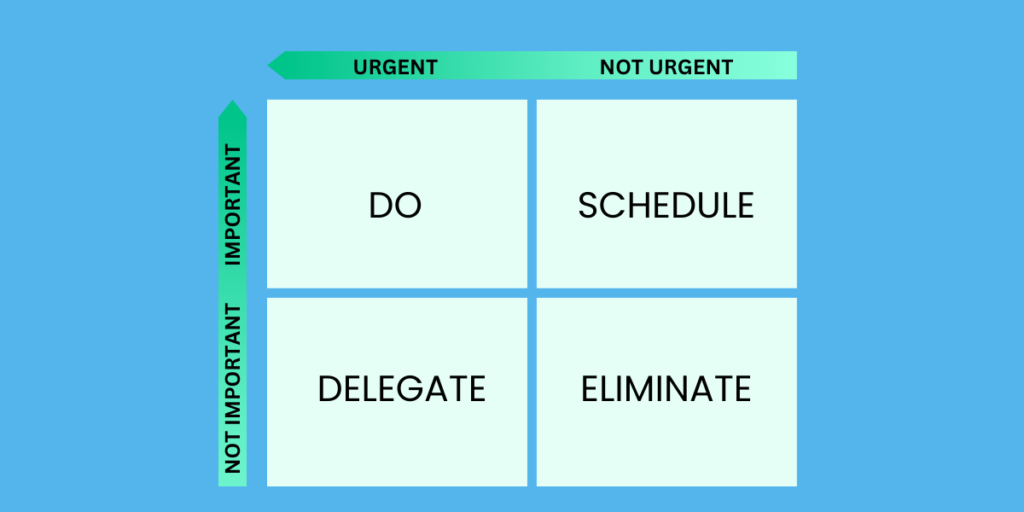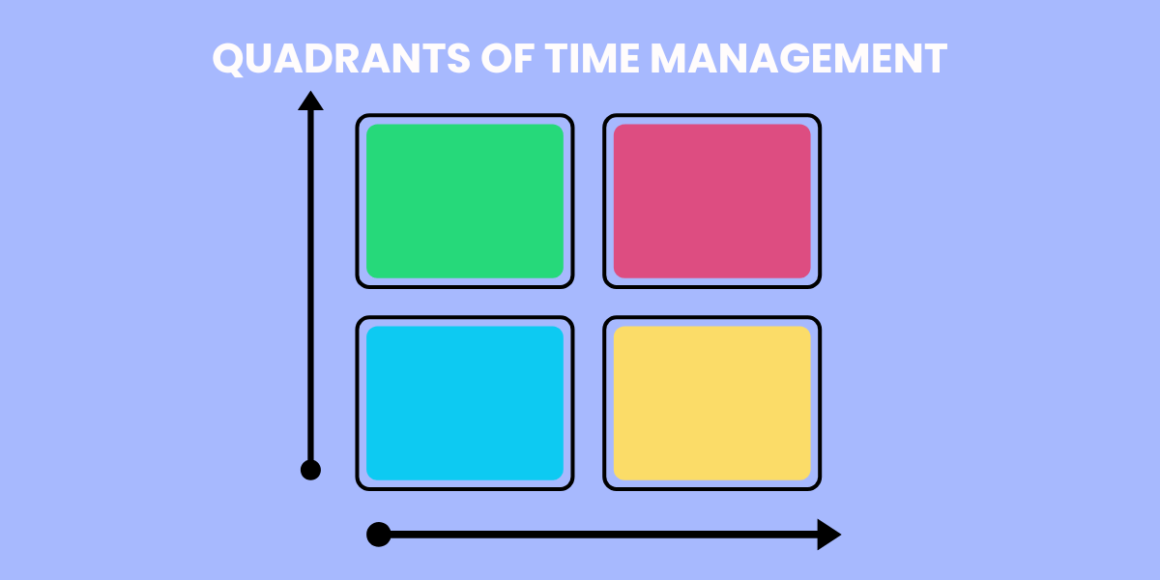Table of Contents Show
Time management is a challenge many of us face in our fast-paced lives. With endless tasks vying for our attention, it can be tough to figure out what matters. Enter the time management matrix, a powerful tool that can help you prioritize tasks effectively.
This matrix, developed by Stephen Covey, divides tasks into four distinct quadrants based on their urgency and importance. Let’s dive into how to use the Covey four quadrants to transform your productivity.
What Is Time Management Matrix?
The time management matrix is a visual representation that helps individuals categorize their tasks. It’s not just about getting things done; it’s about getting the right things done. The matrix is rooted in the idea that not all tasks are created equal.
Some tasks are urgent and important, while others might seem pressing but lack real significance.
Historically, the concept of categorizing tasks based on urgency and importance can be traced back to Dwight D. Eisenhower, who famously said, “What is important is seldom urgent, and what is urgent is seldom important.” Covey built on this idea, creating a more structured approach with his four quadrants.
The time management matrix is a tool that helps individuals prioritize tasks based on their urgency and importance.
It categorizes tasks into four quadrants:
- Quadrant 1: Urgent and Important
- Quadrant 2: Important but Not Urgent
- Quadrant 3: Urgent but Not Important
- Quadrant 4: Not Urgent and Not Important
By organizing tasks this way, users can focus on what truly matters, ensuring they allocate their time effectively and reduce stress.
The Four Quadrants of the Time Management Matrix

Let’s break down the four quadrants of the time management matrix and see how they can help you manage your time more effectively.
Quadrant 1: Urgent and Important
Tasks in this quadrant require immediate attention. They are both urgent and important, meaning they need to be addressed right away. Think of crises, deadlines, or emergencies. For example, if you have a project due tomorrow, that task falls squarely in Quadrant 1.
Strategies for Managing Quadrant 1:
- Stay organized: Use a planner or digital tool to track deadlines.
- Prioritize effectively: Focus on completing these tasks first to avoid last-minute stress.
- Set boundaries: Learn to say no to tasks that don’t fit into this quadrant.
Quadrant 2: Not Urgent but Important
This quadrant is where the magic happens. Tasks here are important for your long-term goals but aren’t pressing. Examples include planning, personal development, and relationship building.
For instance, working on a professional certification or developing a new skill is crucial for your growth but may not have an immediate deadline.
Importance of Prioritizing Quadrant 2:
- Invest in yourself: Spend time on activities that align with your long-term objectives.
- Schedule time: Block out specific times in your calendar for these tasks to ensure they get done.
- Reflect regularly: Review your goals and adjust your focus as needed.
Quadrant 3: Urgent but Not Important
Tasks in this quadrant may feel urgent, but they don’t contribute significantly to your goals. Think of interruptions, emails, or meetings that don’t require your full attention.
For example, a colleague asking for help with a task that isn’t aligned with your priorities can fall into this category.
Strategies for Managing Quadrant 3:
- Delegate: If possible, pass these tasks on to someone else.
- Limit distractions: Set specific times to check emails or messages to avoid constant interruptions.
- Say no: Politely decline tasks that don’t align with your priorities.
Quadrant 4: Not Urgent and Not Important
This quadrant is the time-waster zone. Activities here are neither urgent nor important, like scrolling through social media or binge-watching TV shows. While it’s essential to unwind, spending too much time in this quadrant can derail your productivity.
How to Eliminate Quadrant 4:
- Set limits: Allocate specific times for leisure activities to avoid mindless consumption.
- Reflect on value: Regularly assess how you spend your time and adjust accordingly.
- Engage in meaningful activities: Replace low-value tasks with hobbies or interests that enrich your life.
Implementing the Time Management Matrix
Now that you understand the quadrants, how do you put this knowledge into practice? Here’s a step-by-step guide to implementing the time management matrix in your daily routine.
- List Your Tasks: Start by writing down everything you need to do. This can be a brain dump of all your responsibilities, both personal and professional.
- Categorize Tasks: Go through your list and assign each task to one of the four quadrants. Be honest about the urgency and importance of each task.
- Create a Schedule: Based on your categorization, develop a daily or weekly schedule. Focus on completing tasks in Quadrant 1 first, then allocate time for Quadrant 2 activities.
- Review Regularly: At the end of each week, review your progress. Are you spending enough time in Quadrant 2? Are there tasks that need to be re-evaluated?
- Stay Flexible: Life is unpredictable. Be prepared to adjust your schedule as new tasks arise or priorities shift.
Benefits of Using the Time Management Matrix
Using the time management matrix can lead to significant improvements in your productivity and overall well-being. Here are some key benefits:
- Improved Focus: By categorizing tasks, you can concentrate on what truly matters, reducing overwhelm.
- Better Decision-Making: The matrix helps you prioritize effectively, ensuring you spend your time on high-impact activities.
- Reduced Stress: Knowing what to focus on can alleviate the pressure of juggling multiple tasks.
- Enhanced Growth: By prioritizing Quadrant 2, you invest in your personal and professional development.
Common Challenges and Solutions
While the quadrants of time management can be incredibly helpful, you might encounter some challenges. Here are a few common issues and how to tackle them:
- Difficulty Categorizing Tasks: If you’re unsure where a task belongs, ask yourself: “Is this task urgent? Is it important?” If it’s both, it’s in Quadrant 1. If it’s important but not urgent, it’s in Quadrant 2.
- Procrastination in Quadrant 2: It’s easy to push off important tasks that lack urgency. Combat this by setting deadlines for yourself and breaking tasks into smaller, manageable steps.
- Distractions from Quadrant 3: To minimize distractions, create a dedicated workspace and establish “do not disturb” periods during your day.
- Staying Disciplined: It can be tempting to slip back into old habits. Regularly remind yourself of your goals and the benefits of using the matrix to stay on track.
Prioritization: The Foundation of Effective Time Management
At its core, prioritization allows individuals to distinguish between tasks based on their urgency and importance. Not all tasks are created equal; some require immediate attention, while others contribute to long-term goals.
By prioritizing tasks, you can create a structured approach to your daily activities, ensuring that you focus on what truly matters.
Benefits of Prioritization
- Increased Productivity: When you prioritize tasks, you can tackle the most critical items first. This approach not only helps you complete high-value tasks more efficiently but also builds momentum throughout the day. For instance, focusing on a major project in the morning when your energy levels are high can lead to significant progress before distractions arise.
- Reduced Stress and Anxiety: A long to-do list can be overwhelming. Prioritization helps break down tasks into manageable chunks, allowing you to concentrate on one thing at a time. This method reduces the feeling of being overwhelmed and helps maintain a sense of control over your workload.
- Enhanced Decision-Making: Knowing what tasks are most important enables better decision-making. You can evaluate whether new requests or interruptions align with your priorities, allowing you to say no to distractions that don’t contribute to your goals. This clarity is essential in both personal and professional settings.
- Improved Time Management Skills: By practicing prioritization, you develop better time management skills overall. You learn to identify time-wasting activities and focus on what brings the most value. This ongoing process encourages continuous improvement in how you allocate your time.
Tools and Resources for Time Management
To enhance your experience with the time management matrix, consider using the following tools and resources:
- Apps: Tools like Todoist, Trello, or Asana can help you organize tasks and visualize your quadrants.
- Books: Stephen Covey’s “The 7 Habits of Highly Effective People” is a must-read for understanding the principles behind the matrix.
- Online Courses: Platforms like Coursera or Udemy offer courses on time management and productivity strategies.
Conclusion
The time management matrix is more than just a productivity tool; it’s a framework for making conscious decisions about how you spend your time. By understanding and utilizing the Covey four quadrants, you can prioritize effectively, reduce stress, and enhance your personal and professional growth.
Have you tried using the time management matrix in your life? Share your experiences in the comments below! If you found this article helpful, subscribe for more tips on boosting your productivity and achieving your goals. Remember, it’s not just about managing your time; it’s about making the most of it!
FAQ’s For Quadrants of Time Management Matrix
1. How do I determine which tasks fall into each quadrant of the matrix?
To categorize tasks, assess each one based on two criteria:
1. Urgency: Does the task require immediate attention or have a pressing deadline?
2. Importance: Does the task contribute to your long-term goals or well-being?
Based on your evaluation, assign tasks to the appropriate quadrant. For example, tasks that are both urgent and important go into Quadrant 1, while those that are important but not urgent belong in Quadrant 2.
2. Why is Quadrant 2 (Not Urgent but Important) crucial for productivity?
Quadrant 2 tasks are essential for long-term success and personal growth, such as planning, relationship building, and skill development. By prioritizing these tasks, you can prevent future crises and reduce the number of urgent tasks that arise, ultimately leading to a more balanced and productive life.
3. How can I effectively implement the time management matrix in my daily routine?
To implement the time management matrix, follow these steps:
1. List all tasks: Write down everything you need to accomplish.
2. Categorize tasks: Assign each task to one of the four quadrants based on urgency and importance.
3. Create a schedule: Allocate time for each task, focusing on Quadrant 1 first, followed by Quadrant 2.
4. Review regularly: Assess your progress and adjust your tasks as needed to stay on track.
4. Can the time management matrix be used in team settings?
Yes, the time management matrix is effective in team settings. It can help teams prioritize collective tasks, ensuring everyone is aligned on what needs immediate attention and what can be planned for later. By using the matrix, teams can enhance collaboration and improve overall productivity.
5. How often should I update my time management matrix?
The frequency of updating your time management matrix depends on your workload and personal preferences. Some people find it beneficial to review and update their matrix weekly, while others may need to do it daily. Consistency is key, so choose a schedule that works best for you and stick to it.
6. How does the time management matrix differ from other time management techniques?
The time management matrix specifically focuses on distinguishing between urgency and importance, which helps users prioritize tasks effectively. Other techniques may not emphasize this distinction, leading to a focus on completing tasks without considering their overall impact on goals and well-being. The matrix encourages a more strategic approach to time management.
More Readings For You:










